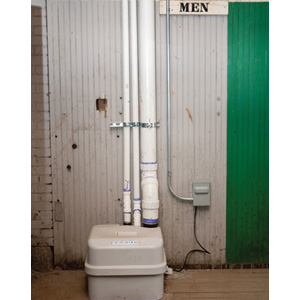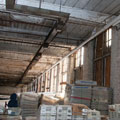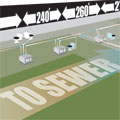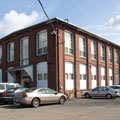
SEVEN DFUS FLOW INTO THE FOURTH GRINDER PUMP UNIT. PHOTOS BY CARYN B. DAVIS
From bicycle wheels to automobiles to typewriters and electronics, a sprawling commercial complex in Middletown, Conn., a city that sits along the Connecticut River 16 miles south of Hartford, has held an important place in the state’s economic history since 1897.
The cutting-edge manufacturing hub and center of heavy industry meant technological advancement and jobs. But over the decades, the work took an environmental toll on the area, contaminating the surrounding soil and groundwater while also polluting the nearby Mattabesset River.
The property was finally foreclosed in 1999 when the rundown site was taken over by the city of Middletown.
Storied Past
The facility still carries the familiar name Remington Rand. According to a history of the site, the Noiseless Typewriter Co. took over the property from the Eisenhuth Horseless Vehicle Co. in 1909. Remington Rand formed after a number of mergers and reorganizations and continued producing typewriters and other products. The company merged with Sperry Corp. in 1955, becoming Sperry Rand. The Remington Rand division closed the factory in the early 1970s.Today, the site is in the midst of a substantial, city-led cleanup and renovation effort designed to help attract emerging businesses and create jobs. Bringing the facility’s outdated plumbing into the 21st century to eliminate pollution is the effort’s centerpiece.

This is a longer view from the point where the discharge from the third
unit enters the main.
Restoring Its Former Glory
“The building was a disaster when the city took it over,” saysWilliam Warner, Middletown’s director of planning, conservation and development.The area, all but abandoned, was filled with junked cars and other debris and had become a host for illegal activity. All the refuse needed to be removed, but the city also had to deal with a serious pollution problem.
“The property was never tied into the Middletown sanitary sewer system,” Warner explains. “When it was built in 1890, the plumbing was designed to flow into the nearby river. So we took it over and started the cleanup, looking for a way to solve the [plumbing] problem.”
Initially a septic system seemed the way to go, but when workers dug for sewer lines, they couldn’t find them. A piping map dating back to 1956 turned out to be inaccurate. A camera was used to trace the line.
“We found out the sewer lines were 15 to 20 feet in the ground,“ Warner says. “We went to where the sewer was out-flowing and there was groundwater in the old clay pipes.”
That eliminated using a septic system.
Making matters worse, contamination was found nearly everywhere, so digging to install new sewer lines and plumbing wasn’t an option either. At that point, the city turned to the local plumbing community to help solve the dilemma.

AL WARREN IS SHOWN IN A SWAMPY AREA ON THE PROPERTY.
A Simple Solution
The city, flummoxed with the situation, encouraged licensed plumbers to bid on the project.“We didn’t have a lot of money to spend,” Warner says. “We wanted a design-build alternative for the interior sewer main. We told them they could not dig in the ground, and they would have to bring the sewer main to the end of the building where the manhole and tie-in are.”
But there was a further challenge. The Remington Rand building is 950 feet long - the length of more than three football fields - so bidders had to present a solution for moving plumbing waste across this expanse plus another 100 feet or so beyond its walls to the sewer main.
“If you applied the normal plumbing pitch,” Warner says, “you would have more than 20 feet of drop across the 950 feet. The problem is, the first floor is only 12 feet high.”
EnterAl Warren, a 30-year plumbing industry veteran and the owner ofWarren Brothers Mechanical Contractorsin Stafford Springs, Conn. Warren won the contract based on his system design, which uses a series of Saniflo Sanicubic Classic duplex grinder pumps.
“The concept took a little thought, but really nothing is complicated about it,” Warren says. “I called my supply house (The Granite Groupin Colchester, Conn.) and told (Branch ManagerRob Pellegrini) what I was up against and we batted it back and forth and came up with a plan. He had the product, I had the method, and together we got it going.”
The result was the installation of five Sanicubic duplex grinder systems positioned at intervals along the entire length of the building. Each system pumps effluent up through small-diameter pipe into the main, positioned near the ceiling, and out to the sewer.

Figure 1.
How It Works
Measuring 23 3/4 inches wide by 19 1/4 inches deep by 16 1/2 inches high, each unit contains two 1-horsepower grinders capable of processing 60 gallons of effluent per minute.Using any or all of five adjustable outlets (from 1 ½ inches to 4 inches), each unit’s two independently operated grinders have fast-rotating cutting blades that reduce solids in the wastewater stream from fixtures. The product can handle waste from toilets, tubs and showers, sinks, washing machines and dishwashers. Effluent is pumped from the unit through small-diameter PVC or CPVC piping (by Charlotte Pipe) connected to the top of the unit. A 1 1/2-inch stack vent (by IPS) vents to the outdoors.
More specifically at Remington Rand, the five duplex grinders handle wastewater from all 12 plumbing fixtures in the building’s two long floors: five toilets, two urinals, four sinks and a shower (seeFigure 1).
The restrooms on the first floor use Saniflo Saniplus macerating toilets that can be installed on the floor without digging for drainage. The second-floor facilities use conventional gravity-flow toilets (already present when the renovation started) with below-floor drainage.
Plumbing waste from these fixtures is processed in sequence through the five units, which all sit on the slab on the ground floor, driving the combined effluent from the 12 fixtures more than 1,000 feet to the city sewer.
Sanitary Play-By-Play
What follows is a step-by-step description of how the plumbing system works at Remington Rand. Please note a drainage fixture unit is a measurement of the expected discharge from one or more fixtures into the drainage system.Unit No. 1:Second-floor plumbing fixtures with a total discharge of 12 DFUs flow through 4-inch PVC piping into the first unit, which also handles effluent from two macerating toilets (8 DFUs) on the ground floor. The combined effluent from these fixtures (20 DFUs) then flows vertically 12 feet through 1-1/2-inch PVC pipe and 300 feet horizontally through 3-inch pipe. Finally, the effluent flows back down 12 feet through 4-inch PVC into the second unit.
Unit No. 2:Additional fixtures from the second floor (18 DFUs) drop down into this unit, combining with the effluent from the first unit. The combined 38 DFUs are then pumped 240 horizontal feet and then flow into the third unit.
Unit No. 3:An additional macerating toilet (4 DFUs) also pumps into the third unit, bringing the total flow to 42 DFUs.
Unit No. 4:The remaining second-floor fixtures (7 DFUs) flow into the fourth grinder, combining with the 42-DFU flow from the first three units, for a total of 49 DFUs. The waste is then relayed 260 feet horizontally and then down into the fifth unit.
Unit No. 5:This last unit in the sequence handles 4 DFUs from a macerating toilet. This effluent is pumped up to join with the cumulative flow from the other four units. A total of 53 DFUs are then pumped 275 horizontal feet out of the building and into the sewer.
“Our design essentially relocated the sewer main from the slab to the ceiling between the first and second floors,” Pellegrini explains. “The pitch is quite long and quite steep (1 1/4 inches per 10 feet). We had to avoid the beams and several doorways with roughly 400 feet or so between them. We ran the main a few hundred feet, then dumped its contents into a grinder, pumped it up to the ceiling and ran it another few hundred feet horizontally before dumping it into the next grinder, and so forth.
“It’s like a stair effect. Without it, you could never get the right pitch in the pipe in such a long building.”
Staging the duplex grinders with some separate piping also avoids potential problems that could result when units flow into one another and create a high flow rate (a wave effect could trigger a level alarm).

The first of the five grinder pump systems is installed at the front of
the building.
`Very Creative' Solution
The new plumbing system at Remington Rand not only solved an immediate problem, but also kept the future in mind.“If there had been no contamination around the building, it might have made sense to install new drainage pipe, but it would not be the best solution because you don’t want the maintenance of a septic system the rest of your life,” Warner says.
Pellegrini labels the system “a home run.”
Warren, who had not used Saniflo products prior to this job, notes the installation was straightforward.
“I have never had a job like this before, so I was pleasantly surprised,” he says.
While the Remington Rand building may be unique, duplex grinders are applicable for any application and a viable alternative to septic systems and sewage ejectors.
Previously limited - because of the plumbing problem - to renting out only the warehouses on the site, the renovated Remington Rand facility now provides an additional revenue stream for the city. While a former owner is responsible for the vast majority of the environmental remediation, the city earned a $200,000 grant from the Environmental Protection Agency to partially fund hazardous cleanup and community involvement activities.
“We’re embracing a very creative solution to send all of the sanitary waste into a city sewer instead of our river,” says Warner, who notes the expansion will help to create jobs in the area. “It has huge environmental benefits. And once this system is in, we can rent space to new and emerging businesses because we’ll be able to handle sanitary waste properly.”